So I played science games as Shoshone, Spain, and Babylon, and there was also an unreported Poland game in there. Babylon has proved the fastest so far at 185 turns, since they speed up the Great Scientist pipeline on both ends, reaching universities sooner then multiplying the GPP. I want to take a shot with Rome now. I keep figuring out how everything depends on the speed of expanding and developing the cities early, and Rome's 25% building bonus is geared towards exactly that.
I've never quite been sure just how strong that bonus really is. It looks massive but hasn't seemed to make a huge difference in the couple Rome games I've tried. But let's give it a shot.
I'm also going to try out one more adjustment: Liberty over Tradition for once. Of course Collective Rule is exactly how to speed out all those settlers even faster. And Republic along the way is quietly a very strong policy, the best in Liberty, actually more productive than any individual policy in Tradition, and works at its best exactly where we need it in bootstrapping new cities. Republic's hammer even multiplies with Rome's bonus. And it's all perfectly thematic, playing as the Republic of Rome. I'm doing this not exactly because I think Liberty is stronger, but just to try something different and see if I might want to use it for future games.
Other aspects of Liberty: The Pyramids are certainly useful, perhaps better than the Hanging Gardens. The free great person is criminally overrated (nearly useless because it bumps the cost counter so it just steals a GP from the future), but as a scientist-academy it will still help reach Education a bit sooner. And finally, Representation does see some new life in BNW. It's important to complete both Order and Rationalism, which I don't always manage, but the discount from Representation should bring that comfortably within reach.
One more game setup note: For the first time, I chose my AI opponents (this is permitted by CFC HOF rules.) The trick I found last game that the Dutch will sell you their last luxury cheap is well worth deliberately including them. Other important picks are Sweden for the GPP friendship ability; Shoshone because they claim ruins slower (expensive pathfinders) but get luxuries and gold to supply you faster; and Gandhi because he doesn't compete much for map space and easily signs friendship. There weren't any particular standouts besides those so I selected the rest by whim, but left out anything problematic like the Celts' early pantheon, Egypt to compete on wonders, Greece and Siam and Venice to mess with city-states.
As always, I played a few partial starts to find a good map and hone the opening plays. One partial start missed the Pyramids by two turns which annoyed me enough to discard it. A couple others taught me how to tweak the early build order. This is the right plan:
- Startup stuff (scouts, monument, military)
- Settlers out to 7 cities
- Granary, Pyramids
- Remaining settlers
I kept struggling with the question of whether to build the granary before settlers. In favor: growth, and it needs to be in place in the capital to trigger Rome's bonus for the other cities. Against: it does cost those 60 hammers and is useless while building the settlers on the starvation plan.
I also struggled with the question of when to build the Pyramids. You can't let that wonder slide for a long time like the Hanging Gardens; it's an earlier era and a more favored tech and many more AIs go Liberty than Tradition and will build it around turn 80. But interrupting the settler stream for a wonder delays everything down the line for those cities.
Then the right plan hit me. It's 7 cities, then the granary and pyramids. Because those 7 cities will spawn the Great Scientists. Babylon managed this from 9 cities, but adapting that spreadsheet without Babylon's bonus showed that the 900 GPP level would be the latest we could reach fast enough to matter. 900 GPP is the 7th city spawn after accounting for the slots taken by the Liberty finisher and Leaning Tower. So the right plan is to smack down the 7 scientist-producing cities as fast as possible, then put up the granary to trigger Rome's bonus and the Pyramids before the AIs get it, then fill in any more cities we want at leisure since they're not on a tight Great Scientist clock.
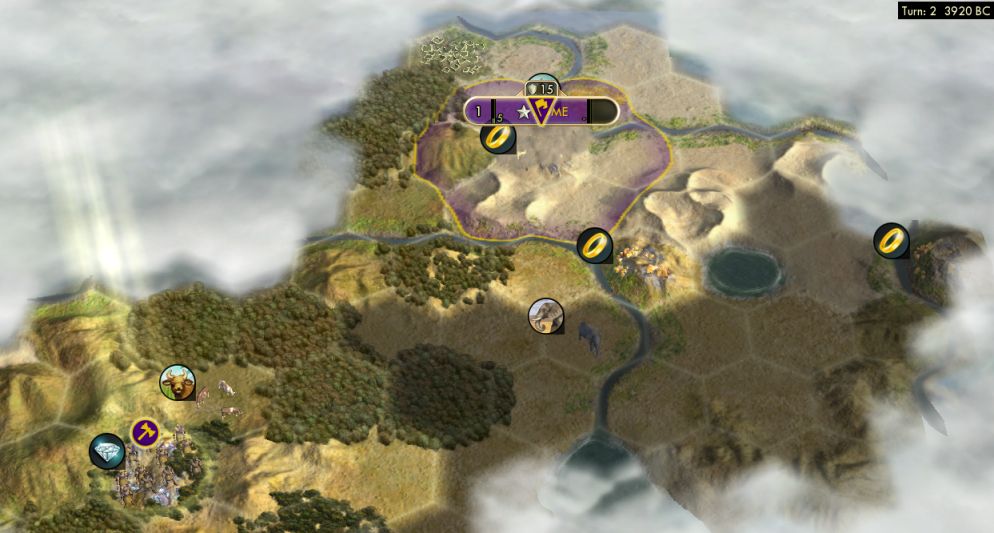
I moved two turns to get on that gold, but found wheat and enough hills and enough desert, so this could work.
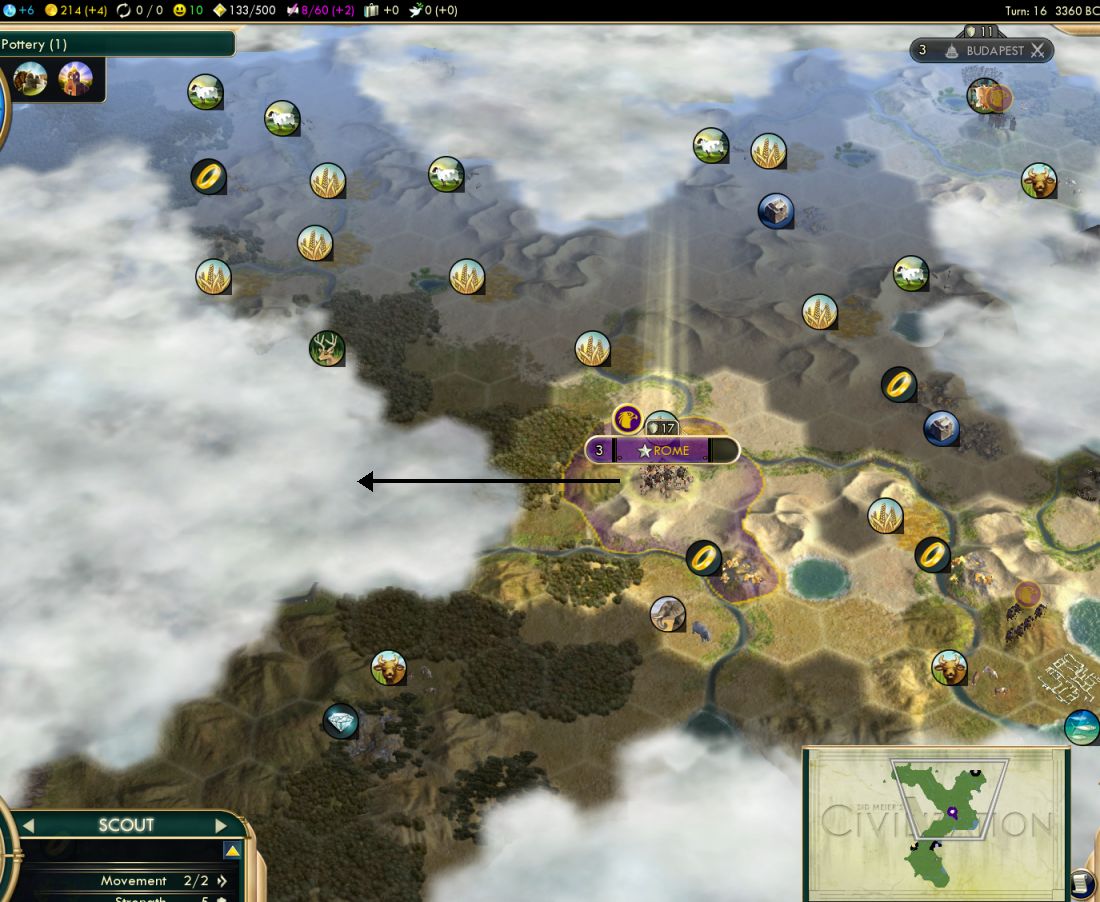
I started with four scouts, even though the starting warrior also kept traveling and didn't return home. Usually I want 4 scouting units on the inland sea, but this time I ended up with a big gap to the west between the first two, so sent out one more to fill it.
The scouts got ruins a bit slowly and not a whole lot early, but just enough from them. Turn 7 came a culture ruin, t9 Mining (with only 3 research turns left on it), t11 60g, t11 survivors to size 3, barbs, t14 culture again, t17 55g, t24 Sailing, t27 third culture, archer upgrade, t30 big faith, t30 Animal Husbandry (also part researched with only two turns left), t32 90g, t38 fourth culture!, t50 late big faith, archer upgrade, t53 50 gold, t54 a FIFTH culture ruin, t55 Masonry (ALSO part researched with two turns left!), t58 gold again (60), t67 SIXTH culture ruin.
Build order was the four scouts - monument - worker - archer - archer - archer - settlers. Tech order was nothing special: Mining - Pottery - Archery - Animal Husbandry - Bronze Working (find iron to settle) - and then I don't remember exactly but it wasn't important.
The first ruin on turn 7 delivered the Liberty opener. I went on to find a huge amount of culture ruins, six in total. The second one got Republic on turn 14 (sorely tempted for Citizenship, but I know from experience that pushes Collective Rule from turn 35 to 55, too late), third one was t27 Collective Rule (too early! had no escort for the settler), t45 Citizenship, t60-some Meritocracy, turn 80 the Liberty finisher.
I also got enough gold ruins and city-states for a worker purchase on turn 19, fast enough. I had gold connected under the city from turn 9 with Mining, but it wasn't until t31 that I found somebody (Attila) with enough money (5/turn) to buy it, then one turn later did the same with Shoshone (6/turn). But I found myself with lots of income quickly from there, as my resource sales came to 3 golds and 4 horses pretty quickly. More worker purchases followed on turns 34, 45, 55, 60, along with a couple retrieved from barbarians.
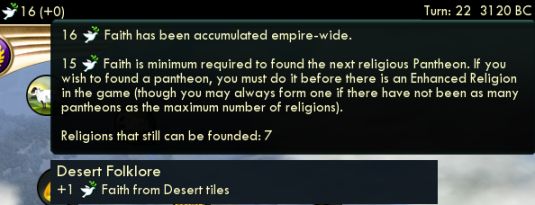
I got the pantheon the good old-fashioned cheaty way this time. Met two religious city-states first for the 16 faith, so didn't have to rely on the ruins method.
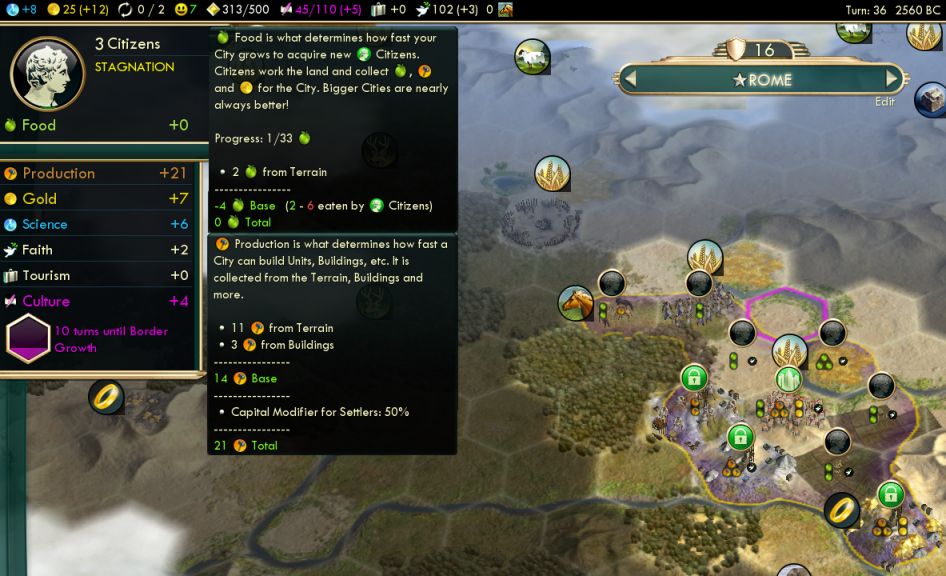
One thing that went significantly wrong was little population from ruins. I only got one, growing the city to size 3. This is where my plan was to start expanding, but this is actually a pretty poor implementation of the starvation settler trick. I reluctantly put off the settlers a bit and worked food for 10 turns to grow to size 4 and add one more tile (the improved horse for 2 hammers.) This was correct, the growth cost was only 33 food and the horse tile with Collective Rule would pay back 3/turn and make it back up by the time we were done making settlers. And in the interim while growing, I could build the granary anyway, despite my earlier plan to let that wait, that would let new cities pick up Rome's building bonus for it immediately.
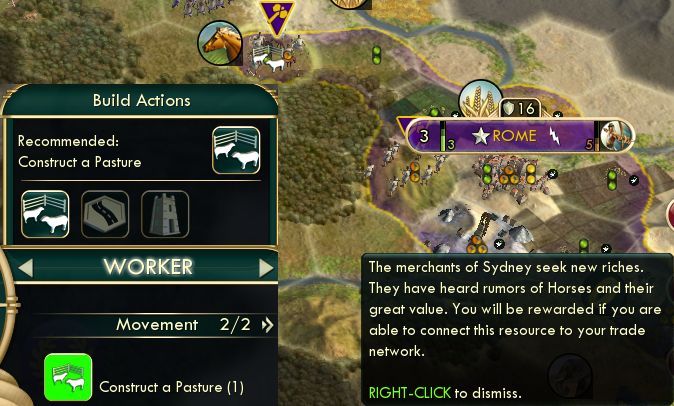
Ha, easiest quest ever. And actually the maritime food even sped the capital's growth by one turn to get to the settlers.
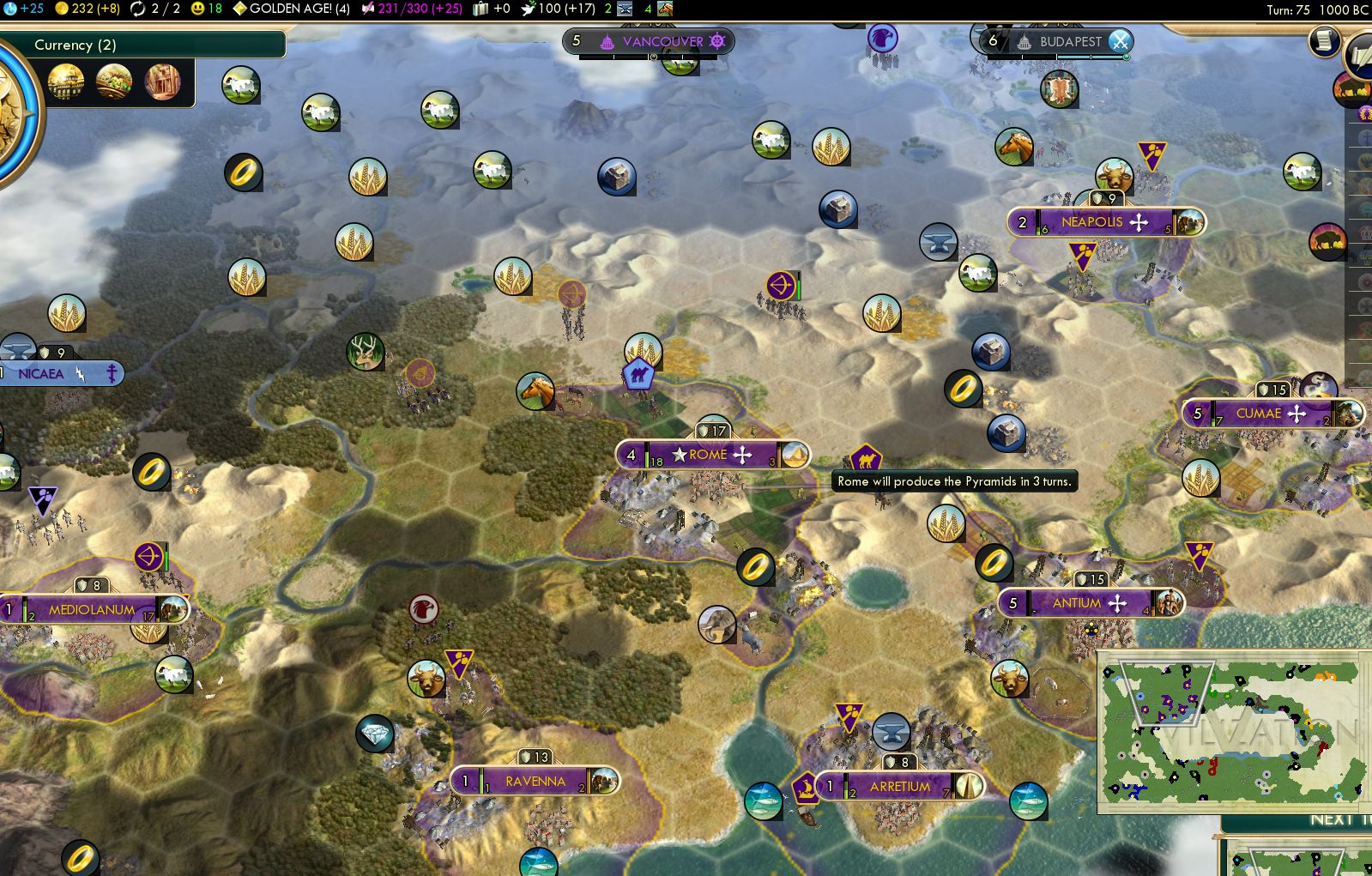
Skipping past the usual stuff of building settlers, escorting them, micromanaging workers, here's the next overview at my usual date of 1000 BC. 7 cities and 19 population, a bit behind my best games but may still be competitive. These 7 cities are the important ones to get going early, that's how many to get up to size and speed to build universities quickly for Great Scientists. I could now pause for the Pyramids. Later cities weren't under the tight Great Scientist clock and could be founded more leisurely.
The one thing that isn't going well is research. Without Babylon's academy, a National College, or a civ with big acceleration, it turns out that this goes pretty slowly. Well, one way to help that was the Liberty finisher coming presently, which I used for a scientist for an academy. This is still much less great than it seems thanks to consuming the 100-GPP slot, but here I actually needed that pretty badly to get my research rate unstuck.
After Currency there, I researched Writing, and bought Rome's library to enable the bonus for other cities. Then right to Engineering, before any of Philosophy or Drama or Civil Service. The whole point of this exercise with Rome and Liberty is to develop the cities quickly and that means aqueducts.
Cumae is about to start Petra in this picture as Currency arrives. Although then I wouldn't get it, missed by about 8 turns. Oh well, not fatal. I have quit maps on occasion for missing Petra, but it wasn't critical here, that city only had about 7 desert hills.
In the religion department, I got my prophet on turn 52, that's good speed. First religious item was a missionary as usual, needed it to convert my two biggest cities as usual, and pressure from them would convert everything else as usual. Then it was all pagodas. A while later (turn 120), I could take a short break from pagodas when several other happiness sources came together (colosseums, Notre Dame) and finally enhanced.
Unusually for an Inland Sea, I was in position to build coastal cities, my southernmost three all are. This is nice for them to swap seaborne trade routes with each other, growing them all substantially. And they each had several hills for production to get the cargo ships built in good time, they weren't overpopulated hammerless sinkholes as coastal cities sometimes end up being.
Friendships: India, Morocco, Netherlands, and Germany all friended me, the last just as I needed it to sell a newly improved gold resource for the full 240 value. I needed that money for this:
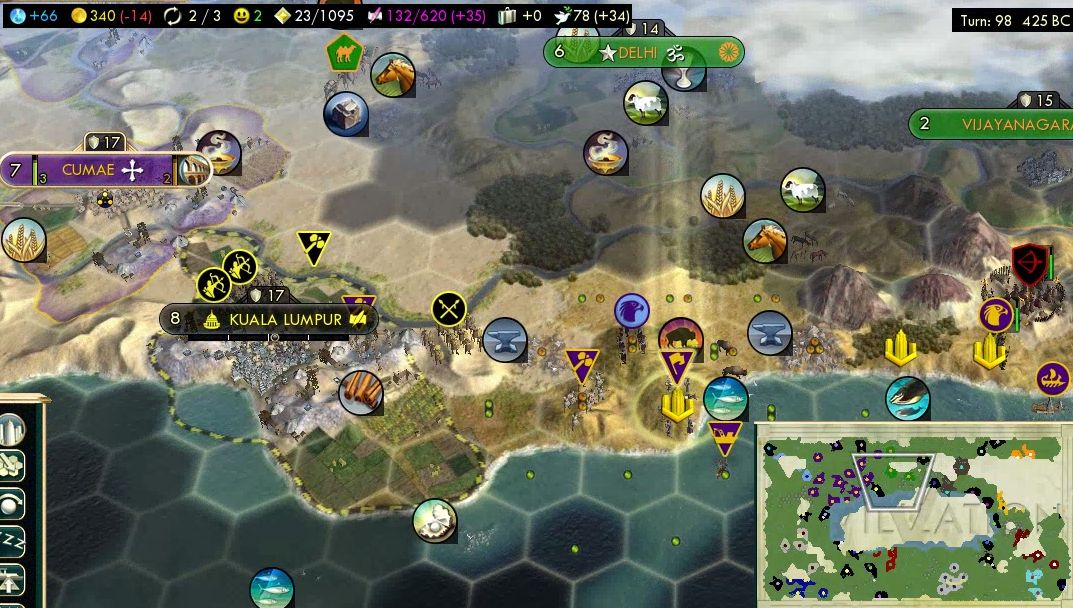
I also added this fourth coastal city. Absolutely worth founding to pick up not just one but two seaborne luxuries, which are quite hard to come by on Inland Sea. Plus also those two iron resources for selling. But I needed the happy right away, so thanks to that money I immediately bought out to the whales tile with a work boat ready to drop on it. A few turns later, did the same thing with another gold sale to buy out to the pearls and drop another work boat.
That picture shows -14 income. This stayed in the crapper for what seemed like forever. I survived on selling lots and lots of gold, horses, and iron. Liberty games really hurt for money compared to Tradition. Building lots of roads didn't help this either. Usually road connections can wait until some time later (when the cities reach size 6 or so is when the connections become profitable and you can spare the worker labor), but with Liberty they have to come early to get Meritocracy's happy.
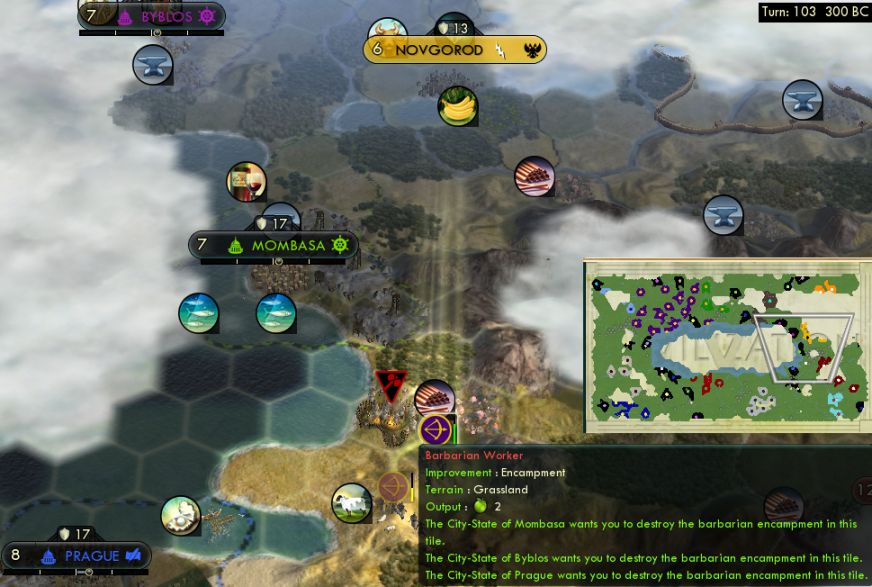
Ok, it's nothing new to clear barbarian camps with scouting units. But this was a four-for-one including the worker, that's still remarkable enough to report.
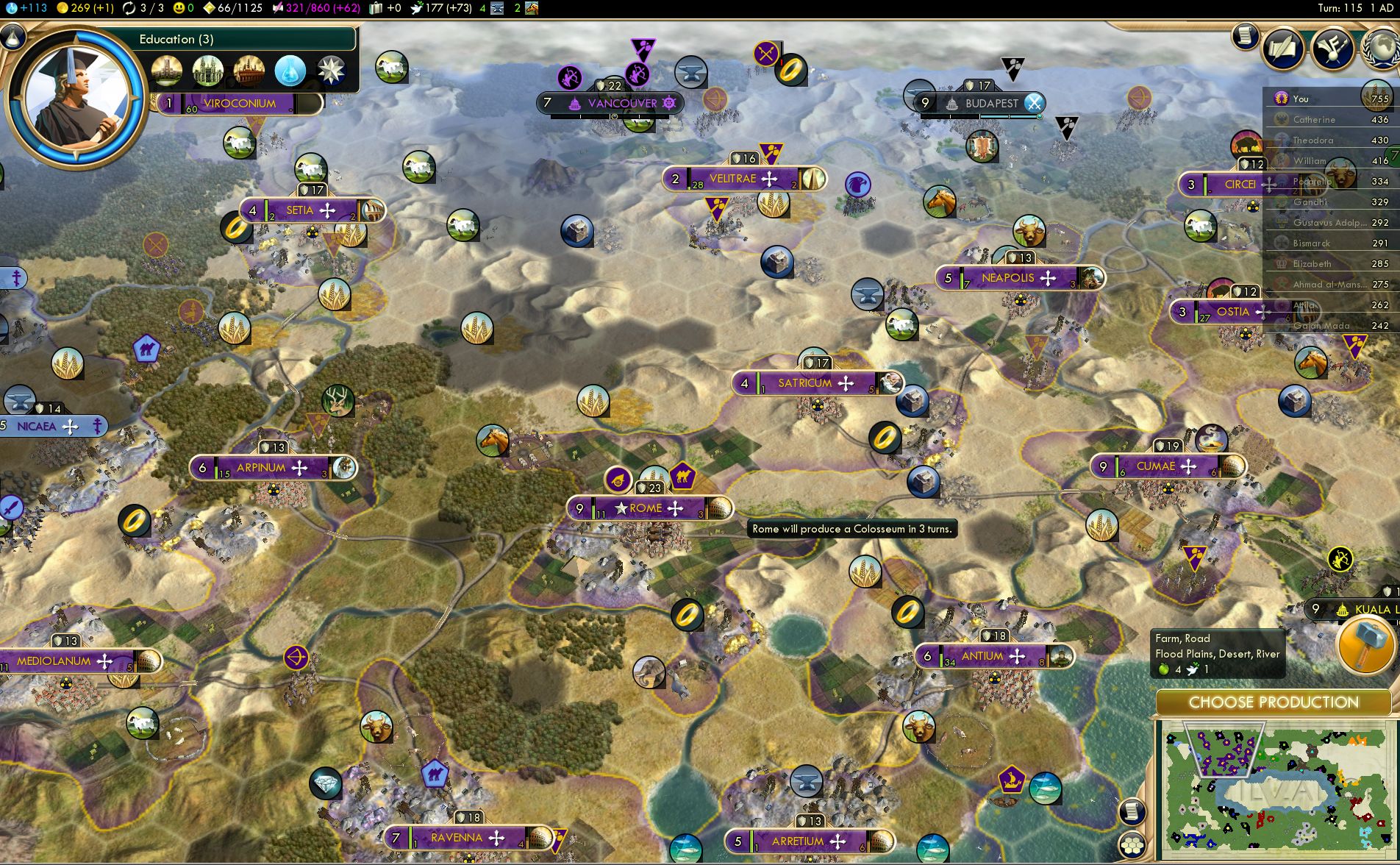
Next overview, at the traditional date of 1 AD.
I hadn't intended for this to be a super-wide game, but just found myself putting out more and more and more settlers, to a total of 15. It was like Civ 4's principle, any site with one food resource was good enough to work with. I had lots of space and couldn't leave it unfilled. And if I'm ever going to try a super-wide game going for space, this is the time, with Rome and Liberty both geared towards it. Rome city couldn't even keep up with the demand for settlers so I even built two out of Antium instead (missing the Collective Rule bonus) because it had developed fast enough and could spare the production. I hadn't intended to settle Viroconium way up in that corner but belatedly discovered a salt resource there, and any city with a new unique luxury is worth founding.
Education is about to come in, although about 8 turns behind where my fastest Shoshone and Babylon games got it. I got a ton of stuff built before universities, though: granaries, aqueducts, circuses, libraries, even watermills and lighthouses. Rome's bonus is certainly doing its thing... although I'm just not sure if its thing is helping. We'll have to see if the wide civ's beaker production can make up the lost ground on earlier research.
Amusingly, this picture caught me at the one moment of not running all of Rome's bonus, building colosseums in several cities but including Rome itself so it's not there yet to yield the bonus. I would shortly fix that for the university builds, buying Rome's with cash from reselling a bunch of iron exports that were about to run out. Later I would buy all of Rome's workshop, public school, factory, and hydro plant for the same reason.
Policies: One consequence of the slow research was failing to reach the medieval era for the 7th policy to go into Commerce. I dumped it into the Patronage opener for lack of anything better. I guess it helps a bit, although the real important consequence of that was unlocking the Forbidden Palace for later in the game. I also missed the Oracle by 4 turns, stupid slow research got me to Philosophy too late. (Although the refund gold from the Oracle was timed just right to buy Rome's university.)
So what I ended up with after Liberty was the Patronage opener in the classical era, then two policies in the medieval era before Rationalism opened. Turn 110 was the Commerce opener. But I wouldn't make it to Mercantilism, so put the one intervening policy into Wagon Trains instead. That actually helped a lot, saving 24/turn on roads in my big empire.
To enter the Renaissance, I went for Banking. This is actually one point that varies a lot between my science games. The Renaissance can be entered at any of Astronomy if there are a lot of observatories to build (not here, had just 2); or Acoustics to get there ASAP and unlock Rationalism if a policy is coming on fast after Education; or Printing Press if the World Congress is a primary concern (Sciences Funding); or here it was Banking because the Forbidden Palace was unlocked and very necessary.
Necessary because, as would be expected for such a wide empire, I was crunching hard on happiness. I managed to survive up until around turn 130 without slowing growth much, thanks to acquiring a lot of luxuries and pagodas, but then hit the wall and I had to halt almost all city growth for about fifteen turns after that. But Notre Dame and then the Forbidden Palace finally resolved that a while later.
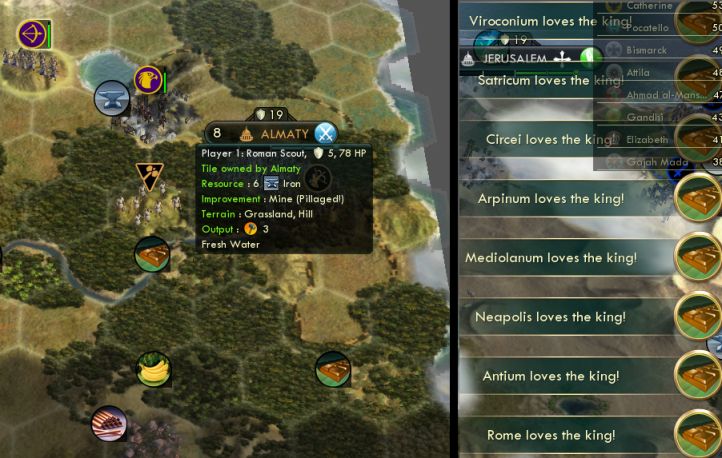
Here's a cute note. I had cleared a barb camp for Almaty here and retrieved that worker for them. I really wanted that cocoa because many cities wanted it for WLTKD. To get Almaty to improve their cocoa faster, I parked my scout on that pillaged iron so the worker couldn't access it, forcing it to find another job, meaning the cocoa.
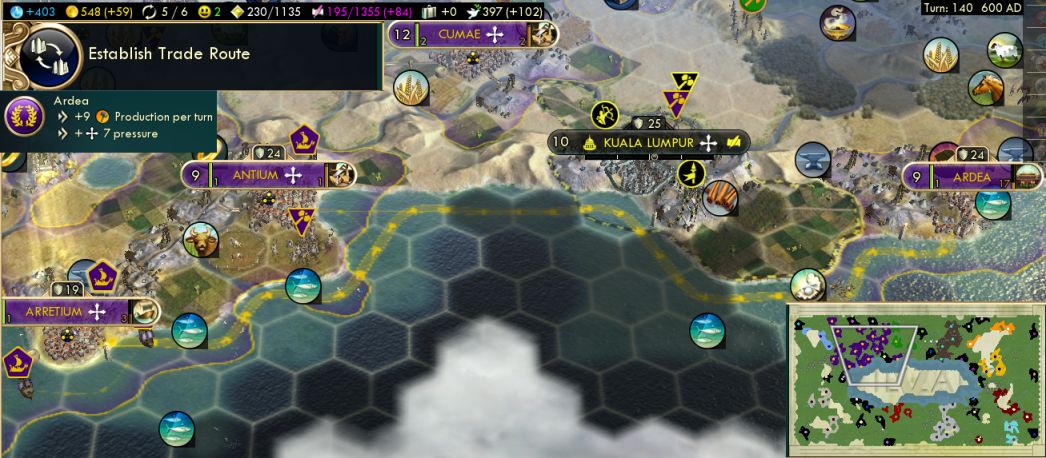
An aspect that went a bit unusually in this game: I had no super cities. I'd missed Petra for one. And Rome city fell far short of the heights you want a capital to reach, because it spent so long building settlers and not growing, had about four hills for production, and importantly lacked the Tradition food multipliers and border expansions. Production trade routes came in to help the coastal cities, but that still just made average cities into good, not great.
The important ramification was that I had to carefully schedule and distribute the wonders everywhere instead of just jamming them all in the capital or Petra. Basically every strong city did one: Notre Dame, Forbidden Palace, Leaning Tower, Sistine Chapel, Globe Theater, Taj Mahal all went in separate cities, and even Oxford and Ironworks took a lot of planning with the national wonder costs escalated so high.
And another area of trouble was money income, the one place where Liberty seriously does suck. Turns out that Tradition's Monarchy, all the cost savings from Legalism and the aqueducts finisher, and even Oligarchy all make a big difference. It took forever but then I finally reached the point where that can turn around, where completing Machu Picchu finally ramped my income way up to over 100/turn. But without Mercantilism as described above, I'd still be far short of enough money to buy all the public schools, and should be building them anyway with Rome's bonus. So I looked for gold sinks. I rarely do this, but bought one city-state, a maritime one, in part thanks to an active gold-gifts-more-effective quest.
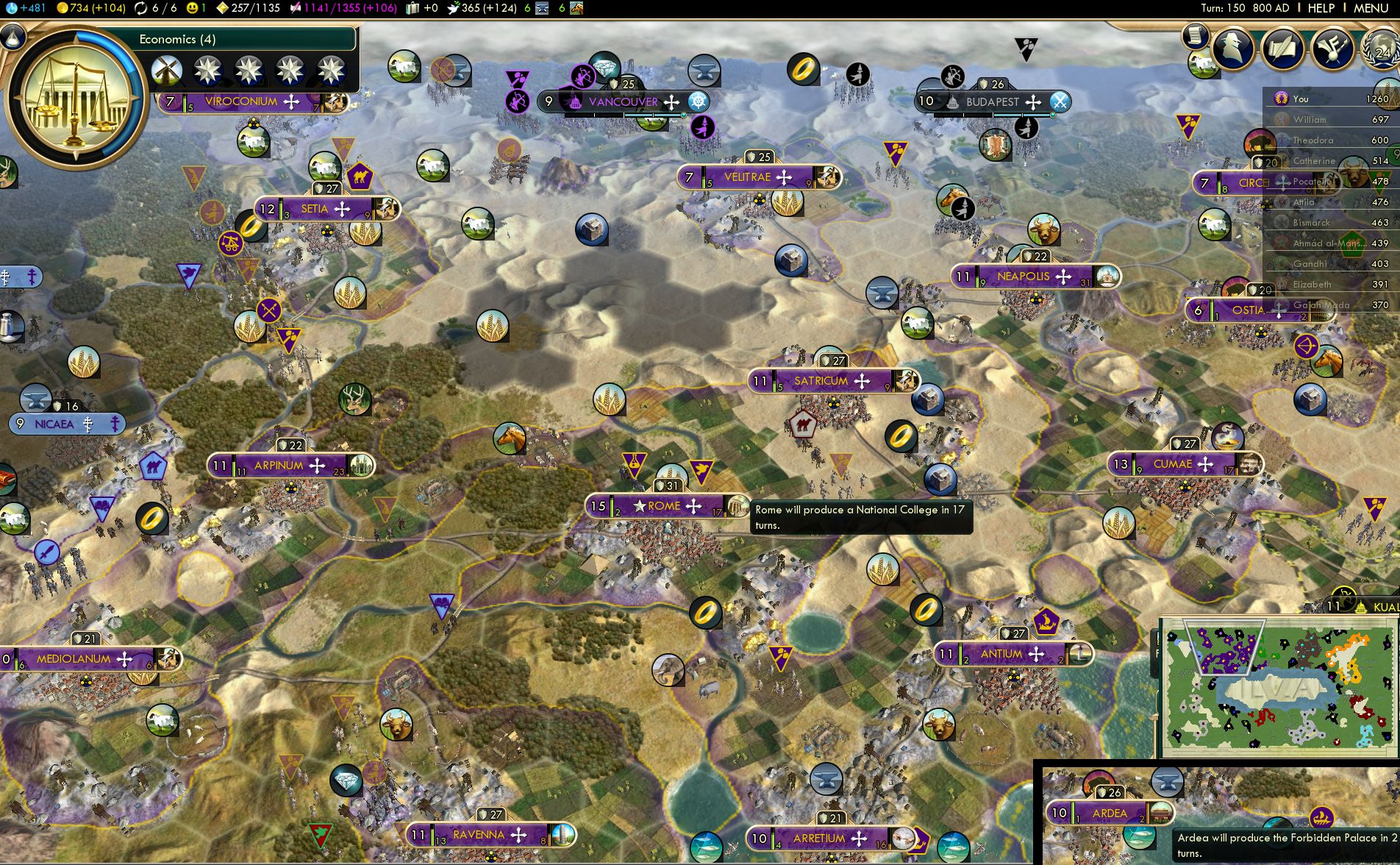
Next overview, in which our speed deficit compared to the Shoshone and Babylon games is starting to become acute. We're two techs away from public schools and will have to slow-build them, while the other games had already bought them before turn 150 here. This game will blow up on beaker and scientist yield in the end-game, but that may come too late to matter. And I can't get over how anemic Rome city is, just size 15 here; size 30 is common with the Tradition food finisher and without spending a hundred turns building too many settlers.
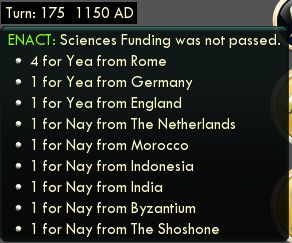 I'm also going to be short at least one Great Scientist and probably two from my original plan of 7 cities. The scientist slots and GPP multipliers just came too late. I also screwed up and failed to get Sciences Funding passed by falling asleep on the job and failing to rotate my diplomats to enough civs in time. I rearranged a few deck chairs on this Titanic, building the gardens and buying one public school to speed up that city, but that still wasn't really going to do much.
I'm also going to be short at least one Great Scientist and probably two from my original plan of 7 cities. The scientist slots and GPP multipliers just came too late. I also screwed up and failed to get Sciences Funding passed by falling asleep on the job and failing to rotate my diplomats to enough civs in time. I rearranged a few deck chairs on this Titanic, building the gardens and buying one public school to speed up that city, but that still wasn't really going to do much.
Policies: t138 Rationalism opener, t153 Humanism, t165 Secularism, t170 writer bulb for Free Thought. Then into Order on t175, with a second writer for Workers' Faculties on the second level right away. Linked with this was the Sistine Chapel completing on t163, and I started an artist Golden Age at the same time, in order to have that culture production synchronized for the 8-turn sliding window that goes into a writer bulb. Liberty was still helping a bit here, with the Representation discount. I wasn't exactly moving through policies fast, but not slow either.
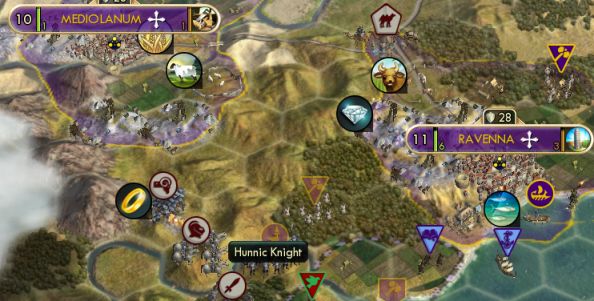 Attila is on fake-friendly mode. Here he comes to attack me. Can I get rid of him?
Attila is on fake-friendly mode. Here he comes to attack me. Can I get rid of him?
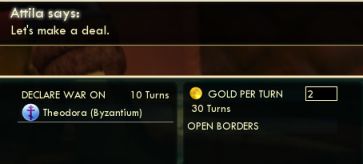 Holy crap that is an insanely cheap price. Yes I will pay 2gpt for you two to go fight each other and not me!
Holy crap that is an insanely cheap price. Yes I will pay 2gpt for you two to go fight each other and not me!
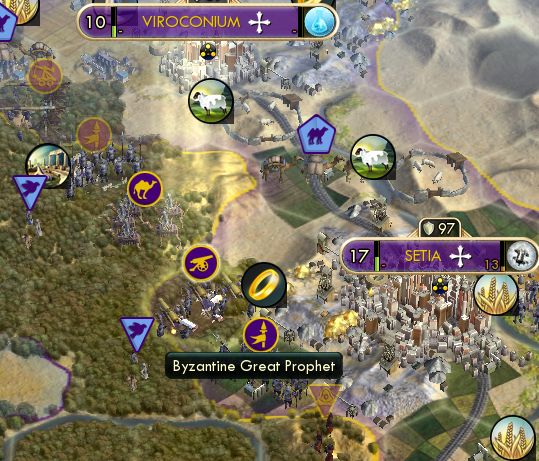
Time for everybody's favorite minigame, form a human wall to block invading prophets. This went on for nearly a hundred turns. This isn't exactly what we had in mind when we said 1UPT in Civ would promote tactical play...
The endgame began on turn 177, when I started spending scientist bulbs. (Except that Babylon finished spending scientist bulbs at this time.) I popped two for 8000 beakers each towards Plastics, reaching it on t180 just as Big Ben completed to start buying research labs. I could only afford 3 labs right at first (still no Mercantilism), but then kept spending all money on them as possible. Rome built Big Ben, then Ironworks, then bulbed to Rocketry to start Apollo.
Turn 183 popped the second artist Golden Age, because that was exactly 16 turns from the third artist, so the two artists sandwiched around Taj Mahal would continue continuously. By the way, there's a subtle quirk that makes it better to chain Golden Ages consecutively. A so-called "8 turn" GA is really just 7, because the counter ticks from 1 to 0 before the turn cycle production phase, so you lose out on that last turn. But that loss only happens once at the end of a GA no matter how long. Separate 8-turn GAs dock you once each, but a combined 24-turn GA docks you just once in total.
Turn 190 bulb Satellites to start the Hubblescope... and OH CRAP WE AREN'T IN TRADITION WE CAN'T BUY A FAITH ENGINEER FOR IT. Had to build it from scratch, starting my best city (Antium) on it right away and abandoning a half-built Kremlin that I had no time to make up elsewhere. Didn't really need it anyway though. I would finish Rationalism but would still come in more than two policies short of finishing Order. Missing the Kremlin only cost me a first-level ideology tenet that I didn't need (the only useful tenets after the GPP and Skyscrapers are all for happy.)
Turn 193 did get my 6th city-spawned scientist as planned. Although that has more to do with the game stretching too far to t193 than with actual well-managed scientist production.
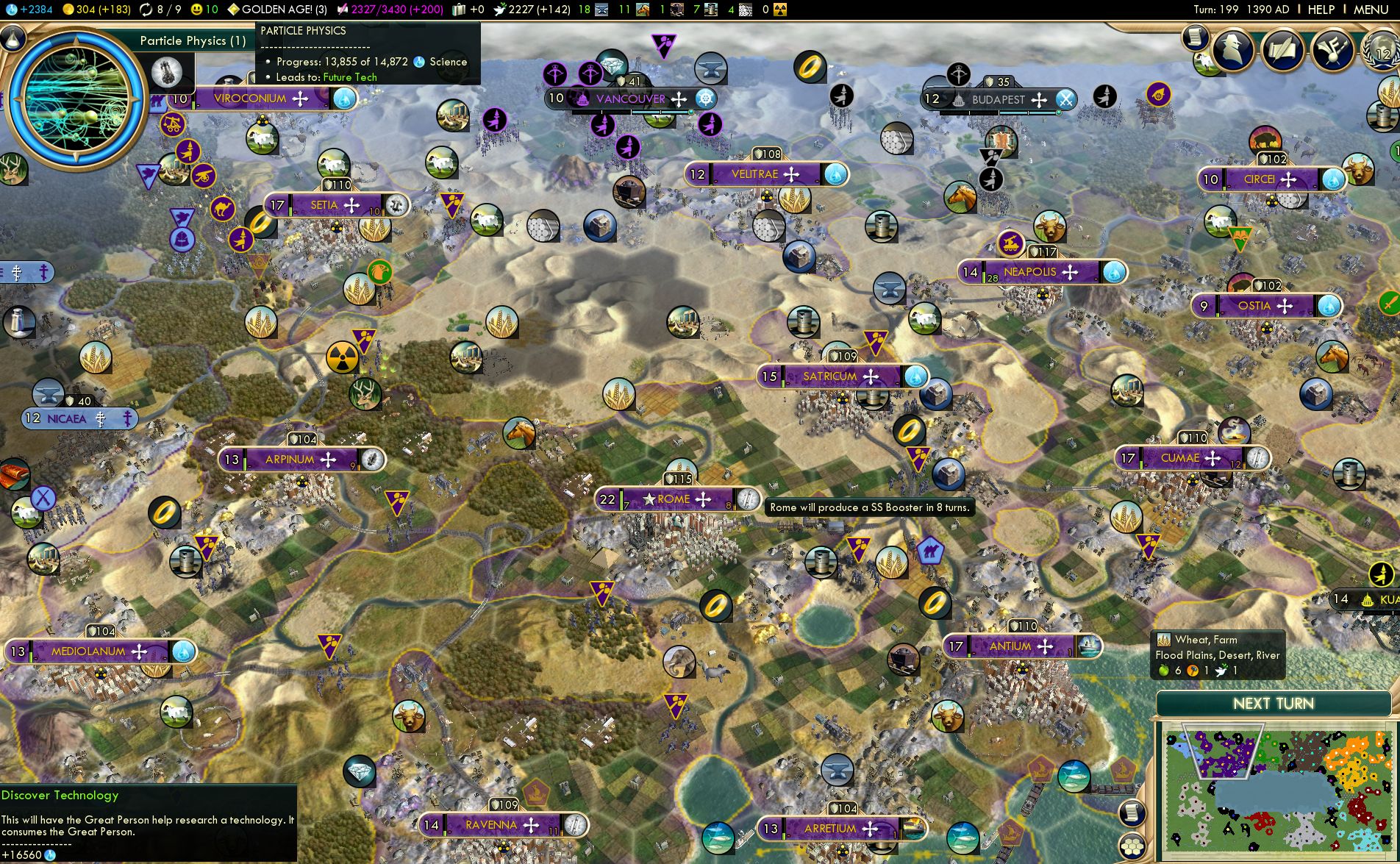
Here's a last overview as the tech tree climaxed. Hubble just finished and I used the last three scientists at 16500 beakers each for Ecology, Telecommunications, Mobile Tactics, overflowing enough from all of them to Particle Physics in a single turn. I pegged the endgame velocity perfectly right for once, neither overshooting nor undershooting the end of the tech tree at all. (You want the final bulb to land one turn short of the last tech and finish it by overflow. If that doesn't happen, meaning you bulbed it directly, that means you've got some overflow beyond it that will be wasted.)
As always, then I sold all the research labs (and still had enough science this turn to finish Particle Physics), all the public schools next turn, and used the money for SS factories and power plants.
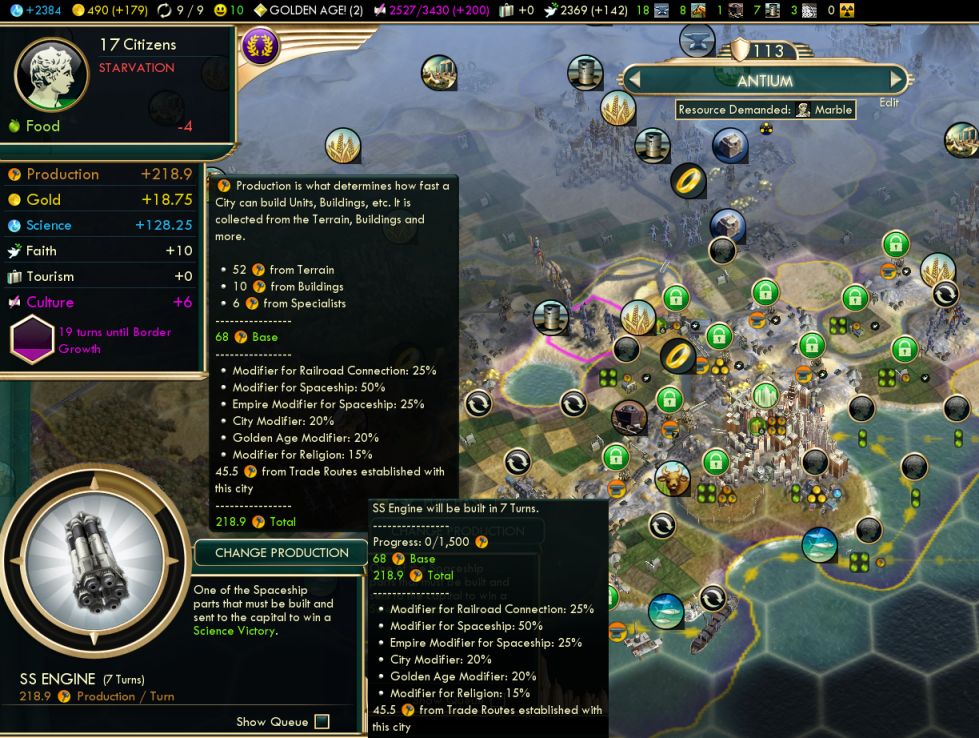
And Antium is well set to build that last SS part, with three sea production trade routes that really get kinda absurd there at the end of the game. Rarely get to play with those on Inland Sea but had fun with it here.
And holy crap I can't believe I never realized this. I looked back at my best science report from the previous expansion and noticed something wild. The spaceship parts in G&K cost 750 hammers but in BNW that's now 1500. Holy crap that's why they keep taking too long to build in all these attempts and why it always seems the Apollo Program finishes too late. Wow. That needs to come at least 12 turns from the end to finish all the parts, not 5 or 6 turns as I always did in G&K. That also means there's a built-in penalty of about five or six turns in BNW times compared to G&K.

Science Victory on turn 207 1470 AD. 22 turns worse than that Babylon game, though.
OK, wide just doesn't work for science. I can't put my finger on exactly why, though. More cities do pay back for their tech cost penalty, which on a huge map is only 2%, and of course each city was producing more than 2% of my empire's total by endgame. But I guess they don't really help either, and the loss is in the opportunity cost of spending for the settler and worker and happy and military to get the city up and running, compared to what else that all could be going towards in advancing existing cities. The more costly spaceship parts hurt wideness as well, indirectly but significantly: more scientists have to go towards Rocketry sooner and not as many can go all the way to the endgame's maximum yield.
Same goes for Liberty. I'm still having a hard time gauging its real strength relative to Tradition. The hardest point to quantify is Liberty's worker advantages via Citizenship and the Pyramids. It is indeed very convenient to improve new tiles and resources in 4 instead of 6 turns (and actually it's even better than that, since you can use the improved item right away on the 4th or 6th turn, meaning Liberty actually cuts the unimproved downtime from 5 turns to 3, better than 50%.) This makes for the little snowbally micromanagey advantages all over the place that I thrive on. But I really have no good sense for if that added up to anything meaningful on the macro scale. But I'm becoming forced to conclude that it doesn't, that Tradition's 15% food finisher just overwhelms all that by sheer quantity.
Where Liberty is supposed to shine is the early acceleration from Collective Rule and Republic. That worked at least, I did expand wide and develop all the cities before universities. Too much so. I developed lots of stuff before universities... but didn't get to them any faster. Liberty let me have more cities ready for universities when I did get there, but that's not what helps, cities beyond the Great Scientist zone just don't do anything. So even as wide as this game was, Collective Rule and Citizenship just don't provide enough juice compared to the Tradition policies and finisher that continue to work all game.
I'm not done here, will have more to say.